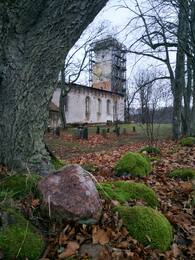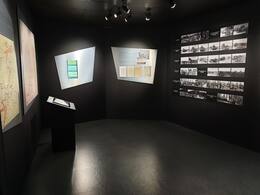Jānis Sūnas's memories of his time spent in the Grieze filtration camp
Lawyer Jānis Sūna has published his memories of his time in the Grieze filtration camp in his autobiographical book.
We were taken away in heavy trucks and dropped off outside Saldus. Then we had to walk to Ezeri, where we were placed in a meadow near the Grieze church, on the banks of the Venta River. Several hundred men were concentrated there: refugees from other regions of Latvia, local permanent residents of Kurzeme, and also Red Army soldiers who had been captured and were employed in the homes of local farmers. The Chekists had invited officers from various military units to help them. I had the impression that the interrogation was repeated. I personally had to write an explanation several times to verify the truthfulness of my statements.
It took about three weeks before I was released. We slept on the bare ground, freezing and warming ourselves by fires. We slept on branches in holes we dug ourselves. The nights were cold. I remember that once my coat, which I had covered myself with, was frosted white. [..]
Sweet Land, 26.10.2021
Among the Five Laws of Power: Jānis Sūnas's memoirs are a unique source of history. Although they were written almost half a century ago, the contemporary relevance of this manuscript is surprising. At a time when passions around the "cheka bags" are burning in domestic society, the myths created during the Soviet era about the events of World War II, including the true role and significance of the Salaspils concentration camp, are collapsing. These memoirs not only provide unique information for historians, but also make any reader relive the situations that the socially active lawyer Jānis Sūnas unwittingly found himself in. In the context of Latvia's centenary, the information that the author provides about 1917, the time when the idea of an independent Latvian state was truly born, is very important. The memoirs have deliberately not been edited much, preserving the author's style and handwriting. It should be noted that writing something like this during the heyday of the Soviet occupation — the 1970s of the 20th century — was a great courage. If the manuscript fell into the wrong hands, it would cause great trouble not only for the writer himself, but also for his entire family.
Related timeline
Related objects
Red Army prisoner filtration camp in Grieze and Grieze Church
Grieze is located at the Latvian-Lithuanian border, where the Vadakste River flows into the Venta River. The Grieze church was built in 1580, but the parish existed before 1567. The church was rebuilt several times - in 1769, in 1845 and in 1773 the first organ was installed. Both the altarpiece and the two bells have been lost for various reasons.
In the church garden there is a cemetery where people belonging to the church and noblemen are buried. One of them is Grieze organist Friedrich Baris and his wife Charlotte, who have a monument erected in front of the church sacristy. On the south side of the church, 32 Swedish soldiers who died in the Great Northern War are buried. The cemetery also contains the graves of 110 German soldiers who died in the First World War, for whom a monument was erected in 1930.
During the Second World War, the church suffered when the front line was stretched along the Venta River in late October 1944 and the German 225th Infantry Division was stationed in the vicinity of Grieze Church. When the Soviet 4th Shock Army launched attacks across the Venta River on 19 November 1944, several artillery shells hit the south wall of the church and the church tower was badly damaged.
After the surrender of Army Group Kurzeme, the Red Army's Leningrad Front accounted for 284 171 people taken prisoner. 7493 were Red Army soldiers released from German captivity. 48 German generals surrendered to captivity. According to the documents submitted at the time of the surrender of Army Group Kurzeme, the number of soldiers was about 185 000. The rest of the nearly 100 000 people subjected to filtration were Kurzeme civilians and Soviet refugees, as the Soviet Leningrad Front ordered on 10 May 1945 that all men between the ages of 16 and 60 be subjected to filtration.
In the Red Army, unlike the armed forces of other countries, the screening, guarding, maintenance and protection of prisoners of war was carried out not by army units, but by the internal affairs bodies - the People's Commissariat for State Security. The main task of the filtration was to detect citizens of the USSR and Soviet-occupied countries who had taken part in the hostilities on the German side. Captured German soldiers were examined in order to detect possible perpetrators of war crimes.
A prisoner-of-war filtration camp was located in the vicinity of the Grieze Church from 10 May to 17 June 1945. The camp was probably located here because the Grieze Church was close to the main roads. The pits in the ground where the prisoners hid from the cold on cold nights by covering themselves with whatever was available are still clearly visible in the surrounding area. During this period, the Red Army caused considerable damage to the interior of the church (all the pews were removed - "for the war effort", the pulpit was damaged, the organ was destroyed, etc.). A laundry was set up in the church building itself.
The last service in the church was in 1950 and the congregation ceased to exist. After the dissolution of the congregation, also later under the supervision of the Latvian Society for the Protection of Nature and Monuments, the church was not repaired. However, the building stood under roof until the 1960s-1970s. The church was damaged during the storm of 1961 and in 1968 the remaining interior elements were rescued by the Rundāle Palace staff.
Since 2003, a group of like-minded people from Riga parishes have been involved in the clean-up and restoration of the church. To date, the church walls have been conserved and the tower has been restored.
Ezere local history repository “Muitas Nams” (Customs House)
The Ezere Customs House is located in Ezere near the Saldus-Mažeikiai highway at the Latvian-Lithuanian border. The act of surrender of the German Army units ‘Kurzeme’ (Kurland) surrounded in the so-called ‘Courland Pocket’ was signed in this building on 8 May 1945. It is believed that World War II actually ended in Ezere. The customs house has an exhibit covering the events of the end of World War II and exhibits detailing the history of Ezere parish from ancient to modern days. In the morning of 7 May 1945, the commander of the Leningrad Front, Marshal L. Govorov, sent an ultimatum to the command of the army group ‘Kurzeme’ to lay down arms. The act of surrender was signed by the involved parties on May 8 and it detailed the procedure of surrender, weapons collection points, documents and information to be submitted and other practical measures.







